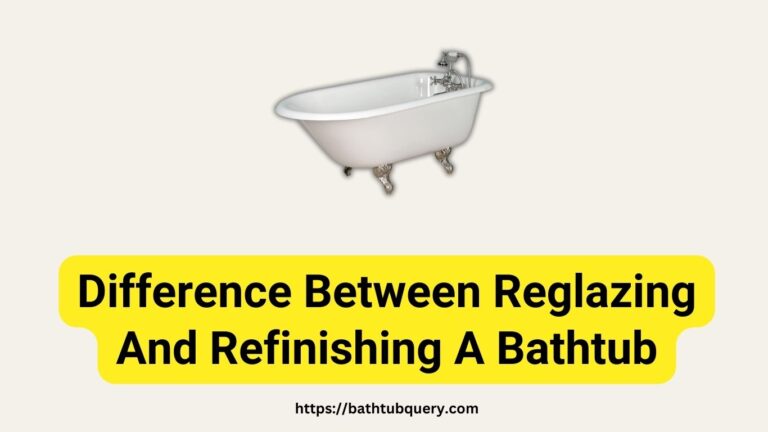How to Clean Your Bathtub Without Bending Over?
Cleaning the bathtub can be a tedious and back-breaking chore. All that bending over the tub to scrub away dirt, grime, and soap scum can put a strain on your back and joints. However, with the right tools and techniques, you can get your bathtub sparkling clean without having to bend and strain yourself.
Why Properly Cleaning Your Bathtub Matters?
Keeping your bathtub clean provides several benefits beyond just making it look nice for guests. Allowing dirt, mildew, mold, and bacteria to build up can create some unhealthy conditions in your bathroom.
- It improves hygiene and prevents the spread of germs that can cause infections.
- Removes stains and mineral deposits that can become difficult to remove if left for long periods of time.
- Prevents mildew and mold growth, which releases spores that can aggravate allergies and respiratory issues.
- Keeps your bathroom smelling fresh instead of taking on a damp, dirty odor.
- Makes your bathroom more pleasant and welcoming for family and guests.
Taking the time to thoroughly clean your bathtub on a regular basis helps provide a healthier, more sanitary environment for your family.
Challenges of Cleaning Bathtub When You Can’t Bend
For those suffering from back pain, arthritis, recent surgery, or other conditions that make bending difficult, cleaning the bathtub can seem like an impossible task. The challenges include:
- Reaching the bottom surface of the tub to properly scrub away grime.
- Scrubbing the walls and sides of the tub involves awkward stretching and straining.
- Accessing corners behind faucets and handles.
- Maintaining balance while stretching to extend your reach.
- Scrubbing areas like tile surrounds requires bending over.
- Repeated bending and stooping motions that aggravate back pain.
When you can’t bend over comfortably, it’s difficult to put enough muscle into the scrubbing motion to efficiently remove soap scum and hardened mineral deposits. Fortunately, there are ways to successfully tackle this cleaning chore without hurting yourself.
Tips for Cleaning Your Bathtub Without Bending
Use Long-Handled Scrub Brushes and Tools
Using scrub brushes with extended handles allows you to apply scrubbing power while in an upright position. Look for brushes with handles at least 3-4 feet long to make it easier to reach all areas of the tub walls and floor while standing. Some good options include:
- Soft-bristle brushes for gentle scrubbing of surfaces like fiberglass or acrylic.
- Stiff-bristle brushes for tougher scrubbing on porcelain or tile surfaces.
- Brushes with sponge heads to cover more surface area.
- Angled brushes to better reach corners.
Lengthwise scrubbing motions work best with long-handled brushes rather than circular motions. Let the bristles do the work for you!
Try Bathtub Cleaning Wands
For concentrated scrubbing power, look for bathtub cleaning wands designed just for the tough grime that builds up in tubs. These wands have an extendable handle with an angled head that allows you to apply downward pressure directly where needed.
Many also have removable scrubbing pads on the head to help customize your cleaning. Look for soft scrub pads for everyday use and stiffer pads for periodic deep cleaning. The wand handle allows you to use both hands to really bear down on stuck-on gunk.
Use Extendable Poles for Hard-to-Reach
For reaching the crevices of faucets, the tops of walls, and even ceiling areas like the shower head, use an extendable pole designed for bathrooms. These poles are like a telescoping duster handle that can extend from a few feet up to 6 feet or more.
Attach different accessories to the end to suit your needs:
- A soft sponge or scrub pad for washing walls or tile surrounds.
- A squeegee to wipe down walls and glass doors.
- A microfiber duster for vents, light fixtures, shower heads.
The poles collapse down when not in use for easy storage. The hands-free scrubbing helps avoid having to balance precariously on the edge of the tub.
Read more about the Bathtub Cleaning Hacks for a Sparkling Tub.
Use Chemical Bathtub Cleaners
Spray-on chemical cleaners are a great hands-free way to let the product do the scrubbing for you. Look for cleaners specially formulated for bathtub grime that you simply spray on, let sit for a few minutes, then rinse off. Some good options include:
- Gel cleaners that cling to vertical surfaces and are thicker than sprays.
- Foaming cleaners that spread widely then foam up to penetrate grime.
- Powder cleaners that you sprinkle on damp surfaces to form a scrubbing paste.
- Daily shower sprays to prevent buildup between deep cleans.
Make sure any cleaner you choose is labeled non-toxic and safe for bathtub surfaces. Avoid anything with harsh bleach or fumes. Proper ventilation is key.
Check out the List Of The Best Bathtub Rust Removers.
Clean in Sections
Rather than try to tackle the entire tub at once, break it down into manageable sections. Do the walls first, then move to the tub floor, then fixtures and faucets last.
Move methodically around the tub rather than over-reaching from one side. Sit on a stool or the edge of the tub while cleaning the bottom and walls nearest you. This avoids excessive bending and stretching.
Use a Cordless Vacuum
A great way to finish up after cleaning is to use a cordless wet/dry vacuum to remove any leftover dirt, debris, and cleaning product residue. Look for one with a long, narrow crevice tool to reach into tub corners and crevices.
Many cordless vacuums convert to handhelds for this type of cleaning. This also helps vacuum up hair in and around tub drains between deep cleans.
Cleaning Products to Use
Having the right cleaning products makes bathtub cleaning safer and easier:
- All-purpose bathroom cleaners formulated for soap scum removal. View On Amazon
- Tub & tile sprays designed for ceramic, fiberglass, and porcelain. View On Amazon
- Bleach-free mold removers to prevent mildew buildup. View On Amazon
- Baking soda to gently lift dirt and neutralize odors.
- White vinegar to dissolve soap scum and hard water deposits.
- Scrub brushes with stiff, short bristles for concentrated cleaning.
- Microfiber cloths that absorb soap scum so it rinses cleanly.
Avoid any cleaning products that contain toxic chemicals and go for green, eco-friendly options whenever possible. Properly ventilate and read all label safety instructions.
Medical Conditions Making Bathtub Cleaning Difficult
Those suffering from certain medical conditions and physical limitations may find it difficult to bend and stoop to clean a bathtub properly. Some examples include:
- Back injuries, arthritis, fibromyalgia, or chronic back pain.
- Recovery periods after surgeries, especially hip, knee, or back procedures.
- Pregnancy as the belly grows larger.
- Disabilities related to age, illness, or mobility issues.
| Condition | Risks |
|---|---|
| Arthritis (rheumatoid, osteoarthritis) | Increased inflammation of joints from bending and stretching |
| Chronic back pain (herniated discs, sciatica, etc.) | Straining of muscles leading to spasms and increased pain |
| Recent surgery (knee, hip, back procedures) | Over-stretching healing incisions and muscles |
| Pregnancy | Throwing off balance and falling |
| Fibromyalgia, chronic fatigue | Flare up of muscle pain and fatigue |
The good news is that the cleaning tips provided above allow you to keep your bathtub fresh and hygienic without risking further pain or injury. Protect your health while still having a clean and welcoming bathroom environment.
FAQs
What cleaning products work best for cleaning bathtubs without bending?
Look for long-handled brushes, bathtub cleaning wands, extendable poles, and sprays or gels that cling to surfaces so you don’t have to scrub.
Can I clean my bathtub while pregnant?
Yes, use a stool to sit and avoid bending. Use long handles and chemical cleaners to avoid heavy scrubbing.
How do you clean a bathtub with arthritis?
Use handles at least 3–4 feet long to avoid bending and minimize arthritis pain. Break into sections.
How do you clean soap scum out of a bathtub?
Spray cleaners formulated for soap scum, let sit, then wipe away. Use baking soda and vinegar too.
How often should you clean the bathtub?
Clean the bathtub weekly by wiping down the walls and rinsing the floor. Deep clean monthly with scrubbing to remove buildup.
Summary
Cleaning the bathtub without having to bend over is totally possible with the right approach and tools. Use long-handled brushes and cleaning wands to do the scrubbing work while standing upright. Tap into the cleaning power of sprays and gels that do the work for you. Break the tub into sections and use stools or chairs so you don’t have to hunch over.
Focus on problem areas like soap scum buildup, grimy rings, mildew, and mineral deposits. Avoid toxic chemicals and open windows to keep the area ventilated. Disinfecting and descaling your tub not only keeps it looking shiny and new, but also helps protect your family’s health.
Take your time and pace yourself. Listen to your body so you don’t overexert sore muscles or joints. You may need to enlist someone to help with hard-to-reach areas. The results will be worth it – a clean, inviting bathtub you can relax in and enjoy with confidence. No more dreading this chore!
Read more:

William J. Bullock is a licensed plumber with over 15 years of experience installing and repairing bathtubs. He runs his own plumbing company in Greenville and serves residential and commercial clients. William is dedicated to providing honest, transparent advice to help homeowners make informed decisions about their bathroom renovations.
He has established expertise in selecting bathtubs, planning custom installations, diagnosing issues, and completing repairs. William aims to share practical tips and reliable recommendations based on extensive hands-on work. When he isn’t on a job site, William enjoys spending time with his family and volunteering at local community events. He takes pride in delivering quality service and enjoys helping people upgrade their homes.







